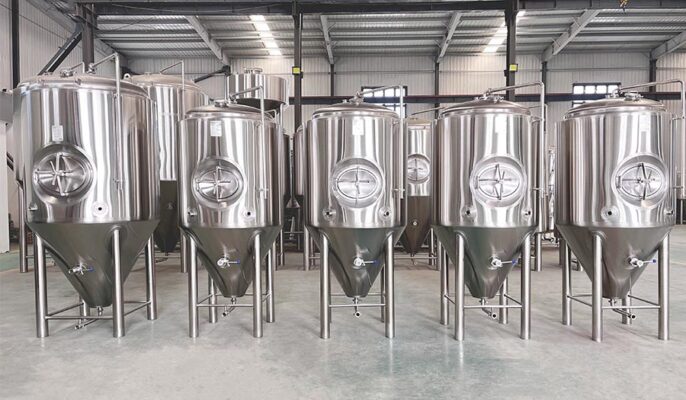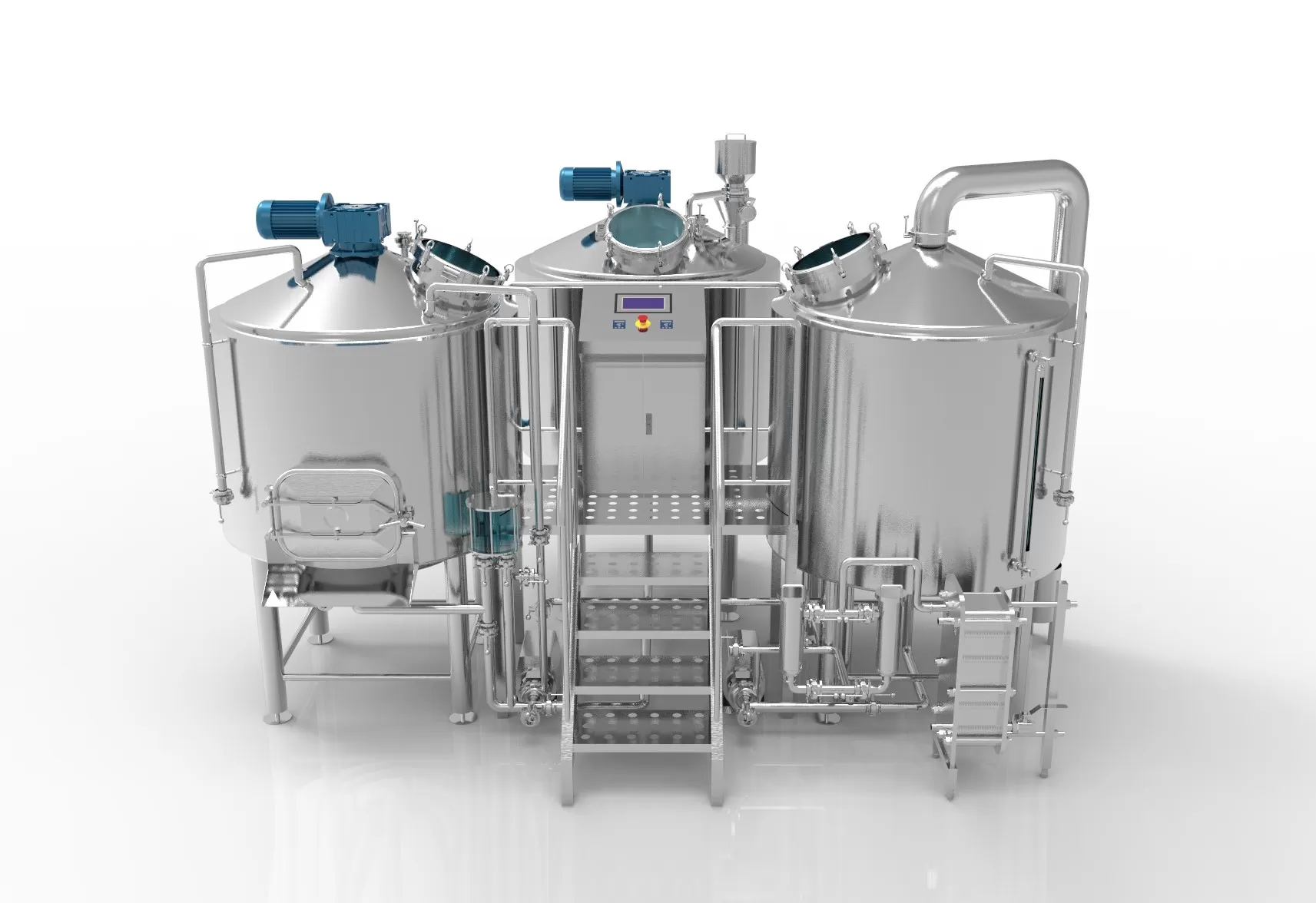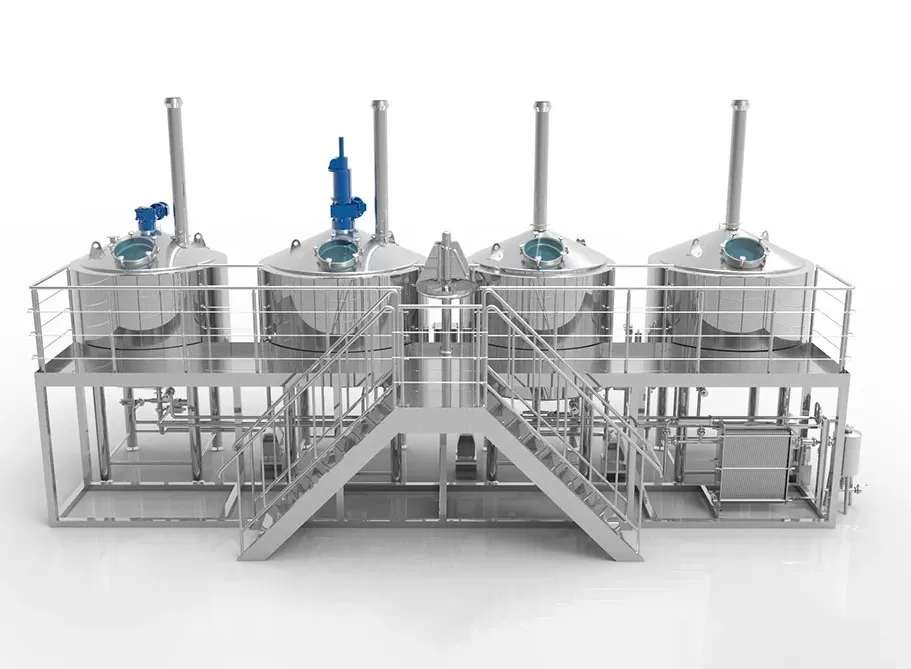The gold standard for beer brewing is the conical fermenters, a tank with a bottom that tapers into a funnel. simplifies the home brewing process, saving you time, money, and storage space. Whether it is a 250 L conical tank for home brewing or a 10,000 L conical tank, it is an important piece of equipment for any brewery or beverage production facility. They are used to ferment and store a variety of beverages, including beer, wine, cider, and kombucha.
Что такое конический ферментер?
A conical fermenter is a cylindrical tank with a conical bottom. Cone angles range from 60 to 90 degrees, with 60 or 70 degrees being the most common. The conical shape separates fermentation products from spent yeast and other solids, which collect at the bottom of the tank and can be removed through a valve at the conical bottom.
Conical fermenters are made of food-grade stainless steel and are available in a variety of sizes to meet the needs of different breweries and beverage production facilities. They are also equipped with various features such as temperature control systems, pressure gauges, and stirring devices to help ensure consistent and controlled fermentation.
Characteristics of conical fermentation tanks
- Food grade 304/316 stainless steel structure
- Double-walled cooling jacket with pits
- Inner surface 2B smoothness and passivation
- Extra large capacity, capable of 25% headspace fermentation
- sanitary three-clamp sampling valve
- Верхний напорный или боковой бестеневой люк
- Температурная гильза PT100 с датчиком
- Rotating rocker arm on cone
- Dry hop addition port 4/6inch
- 360° covering CIP spray ball
- Threaded ice water inlet/outlet
- Клапан сброса давления с манометром
- Lifting rod on the top edge of the tank
- Прочные ножки с регулируемыми болтами
- Safety valve on top of tank
- 60° yeast pouring spout

Каковы преимущества конических ферментеров?
- The cone is a “single tank” which means you can do primary fermentation as well as aging/storage in the same vessel. When using a flat-bottomed fermentation vessel, you must transfer the beer to a second vessel to separate the sediment from the beer for aging. But, in a cone, you can open the valve at the bottom, allowing the sediment to drain out but leaving the beer behind.
- The conical shape of the fermenter allows yeast and sediment to settle at the bottom of the container. This makes it easier to collect and remove the yeast, which can then be reused in future batches or discarded as needed.
- Temperature control during fermentation is crucial as temperature fluctuations can affect the final product. Conical fermenters, especially those made of stainless steel, help maintain a consistent temperature throughout the process, ensuring optimal fermentation conditions.
- By having your fermenter higher than your bottling/kegging vessel, you can transfer the wort using only gravity without siphoning. Some closed-top fermenters even allow you to apply CO2 pressure to the top of the fermenter to force the beer out of the bottom and transfer.
- Compared with traditional fermentation vessels, the design of the conical fermentation tank makes it easier to clean and maintain. The smooth sloped surface allows for simple rinsing and disinfection, reducing the risk of contamination and improving hygiene.
Типы конических ферментеров
- Stainless steel: Stainless steel conical tanks are the workhorses of professional breweries, offering unparalleled durability, ease of cleaning, and corrosion resistance. They can handle a wide range of temperatures and pressures and are suitable for every brewing style.
- PET Plastic: PET plastic conical fermenters are lightweight and shatterproof, making them an cheap choice for home brewers. They also have the advantage of being transparent, allowing you to watch the fermentation process. But, PET plastic is scratched and may not be suitable for the high fermentation temperatures used in some beer types.
- Unitanks: These advanced conical tanks combine fermentation and serving functions into a single vessel. They come equipped with a jacket for temperature control and can be pressurized for carbonation, eliminating the need to transfer the beer to a separate keg or bottle. Unitank is great for space-saving setups, but is more expensive and requires a deeper understanding of operation.
|
ТИП |
МАТЕРИАЛ |
CAPACITY RANGE |
ПЛЮСЫ |
МИНУСЫ |
|
Нержавеющая сталь |
Нержавеющая сталь |
1 Gallon – 1000 Gallons+ |
Durable, Easy to Clean, Long Lifespan |
Higher Cost |
|
PET Plastic |
Food-Grade PET Plastic |
1 Gallon – 50 Gallons |
Lightweight, Affordable, Transparent |
Potential for Scratches, Not Ideal for High Temperatures |
|
Унитазы |
Нержавеющая сталь |
10 Gallons – 1000 Gallons+ |
All-in-one fermentation and serving tank, Pressure capable for carbonation |
Complex to Operate, Higher Cost |
The process of cone fermentation
The conical fermentation process itself is not different from using a cylindrical fermenter. But, the conical design simplifies several steps:
- Wort transfer: After the wort is ready, transfer it to a sterilized conical fermenter.
- Yeast pitching: Introduce the yeast strain of your choice at the appropriate temperature.
- Fermentation magic: Let the yeast work its magic, converting sugar into alcohol and carbon dioxide. During this time, you may need to adjust the temperature depending on your yeast strain and desired beer style.
- Sedimentation: After fermentation is completed, yeast and other particles will settle at the bottom of the cone. This process may take several days.
- Transfer the clear beer (rack): Using the rack arms, extract the clear beer from above the sediment layer and transfer it to another container for conditioning, kegging, or bottling.
Precautions when using conical fermentation tanks
- Thorough sterilization: Proper hygiene is essential to avoid contamination and ensure a successful fermentation process. Always disinfect the conical fermenter and any associated equipment before use.
- Watch temperature: Keep an eye on the temperature during fermentation and make adjustments as needed to maintain optimal conditions.
- Use an exhaust pipe: Fermentation will produce a lot of foam and gas. Using a vent can help relieve excess pressure and prevent potential messes.
- Harvest yeast : When collecting yeast from the bottom of the fermenter, be gentle so as not to disturb the remaining sediment.
- Clean immediately after use: After fermentation is completed, clean the conical fermenter as soon as possible to prevent residue accumulation and make the cleaning process easier.
ЧАСТО ЗАДАВАЕМЫЕ ВОПРОСЫ
Q: Does home brewing need a conical fermenter?
A: Not. Cylindrical fermenters are ideal for home brewers, especially those on a budget or with limited space. Yet, conical tanks offer significant advantages ease of use and beer clarity.
Q: What size conical fermenter should I buy?
A: The ideal size depends on your typical batch size and brewing frequency. Also, consider your available space. Homebrewers start with a 5-gallon or 10-gallon conical tank.
Q: How to clean a conical fermenter?
A: Use no rinse disinfectant to clean the entire tank, including the stand arms and lid. Remove the rack arms for more efficient cleaning.




